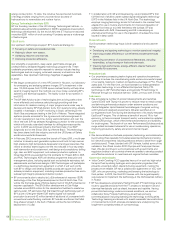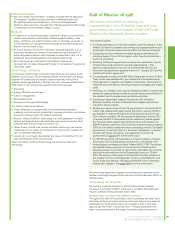BP 2012 Annual Report Download - page 70
Download and view the complete annual report
Please find page 70 of the 2012 BP annual report below. You can navigate through the pages in the report by either clicking on the pages listed below, or by using the keyword search tool below to find specific information within the annual report.
Business review: BP in more depth
BP Annual Report and Form 20-F 2012
68
2012 that BP’s interests in Devenick would form part of the package of
central North Sea assets to be sold to TAQA Bratani Ltd along with the
Braes and Braemar assets and the Harding and Maclure assets.
t In December 2012 BP announced that it had acquired Total’s equity in
the Mungo and Monan Fields for a cost of $155 million. The acquisition
takes BP’s ownership of Mungo and Monan from 69% to 82%.
t In December 2012 gas production from the Skarv field in the Norwegian
Sea commenced. The new Skarv floating production storage and
offloading vessel (FPSO) is expected to produce for 25 years and to be a
key hub for BP in Norway, with production capabilities of 85,000 barrels
per day of oil and 670 million standard cubic feet per day (mmcf/d) of
gas. The vessel is built for adverse weather and is the most northerly
operated FPSO in BP’s portfolio.
t In January 2013 production from the new facilities at the Valhall field in
the southern part of the Norwegian North Sea commenced. Production
from Valhall is expected to build up to around 65,000 barrels of oil
equivalent per day in the second half of 2013.
North America
Our upstream activities in North America take place in four main areas:
deepwater Gulf of Mexico, Lower 48 states, Alaska and Canada. For
further information on the activities of BP’s Gulf Coast Restoration
Organization established following the Deepwater Horizon oil spill, see
pages 59-62. BP is one of the largest producers of hydrocarbons and the
largest acreage holder in the deepwater Gulf of Mexico, operating four
production hubs.
t In 2012 BP started up an additional two rigs in the Gulf of Mexico and
by the end of the year had seven rigs operational. An eighth rig is in
place on the Mad Dog platform and is expected to start up in 2013.
t BP was assigned 51 blocks in the deepwater Gulf of Mexico, 40 blocks
from the 2012 central lease sale that took place in June 2012 and 11
blocks from the western lease sale which occurred in December 2011.
t In June 2012 BP announced the start-up of the Galapagos development
in the deepwater Gulf of Mexico. The development includes the subsea
tie-back to the BP operated Na Kika facility of three deepwater fields –
Isabela, Santiago and Santa Cruz.
For information on the temporary suspension and mandatory debarment
notices issued by the US Environmental Protection Agency (EPA) see
Legal proceedings on page 163.
The US onshore business operates in the Lower 48 states producing
natural gas, NGLs and condensate across nine states, including
production from tight gas, coalbed methane (CBM) and shale gas assets.
For further information on the use of hydraulic fracturing in our shale gas
assets see pages 52-53.
t During 2012 the US lower 48 onshore gas business recognized
impairment losses of $1,458 million primarily in the Woodford and
Fayetteville shales reflecting reduced fair market values in the prevailing
low price environment.
t In March 2012 BP announced it had signed an agreement to lease
approximately 300 km2 in northeast Ohio for future oil and gas
production in the Utica/Point Pleasant shale formation. The agreement
was signed with the Associated Landowners of the Ohio Valley (ALOV),
a group representing area mineral owners.
In Alaska, we operate 13 North Slope oilfields (including Prudhoe Bay,
Endicott, Northstar and Milne Point) and four North Slope pipelines, and
own significant interests in six other producing fields.
t On 30 March 2012 BP, other Alaska North Slope producers, and the
State of Alaska announced the settlement of a long-running legal
dispute about the future development of the Point Thomson field. BP
holds a 32% interest in the Point Thomson field and ExxonMobil is the
operator. Under the terms of the settlement agreement, the working
interest owners committed to an initial gas and condensate cycling
project, with production start-up scheduled for May 2016. A significant
portion of the cost of this initial project will be pre-investment for a full
scale Point Thomson gas development project with production either to
be sold in world markets via a major North Slope gas export project; or
to be transported and injected into the main Prudhoe Bay reservoirs to
increase oil recovery in the near term, and later reproduced and sold.
t Also on 30 March BP, ExxonMobil and ConocoPhillips jointly announced
that they are working together on a plan aimed at commercializing the
extensive natural gas resources on the North Slope of Alaska. The three
companies, along with TransCanada, are assessing a potential LNG
development project.
t In June 2012 BP took the decision to suspend the Liberty project in
Alaska. The Liberty oil field is located approximately six miles offshore
in the Beaufort Sea. In November 2010 BP made the decision to
suspend on-site physical construction of the Liberty rig to conduct an
extensive engineering review and evaluation of the rig design,
materials, and key systems. In the course of this review it was
determined that the rig would require significant changes and
investment in order to meet BP standards, and that these were not
viable. The decision to suspend the Liberty project resulted in an
impairment of the construction-in-progress value totalling $1 billion in
the second quarter of 2012. On 20 November BP filed a request for a
five-year lease extension to pursue alternative development plans. On
31 December 2012 the US Bureau of Safety and Environmental
Enforcement (BSEE) approved a two-year extension for the Liberty
leases until 31 December 2014 to allow BP time to prepare and submit
a new Liberty development plan. BSEE also advised that they will grant
a further extension as necessary to accommodate the regulatory
review, preparation, and issuance of the final Record of Decision by the
agencies on the proposed development project.
t In November 2012 the last remaining claims related to the March and
April 2006 leaks from the Prudhoe Bay Oil Transit Lines were resolved.
On 31 March 2009 the State of Alaska filed a complaint seeking civil
penalties and damages relating to these leaks. In December 2011, BP
and the State of Alaska entered into a Dispute Resolution Agreement
that provided for a $10-million payment attributable to the state’s
environmental and attorneys’ fee claims, and binding arbitration of the
state’s claims for royalty income damages, if any, arising out of the 2006
oil spills and related production shut-ins and pipeline replacements. The
arbitration panel issued its final award on 31 October 2012, which
required BP to pay the state $245.7 million. After reimbursement from
the other Prudhoe Bay owners, BP’s net working interest share of the
arbitration award and the other claims was $64.8 million and $2.6 million
respectively. Payments to the state were made on 13 and 14 November
2012.
In Canada, BP is currently focused on oil sands development, and intends
to use in situ steam-assisted gravity drainage (SAGD) technology. This
uses the injection of steam into the reservoir to warm the bitumen so that
it can flow to the surface through producing wells. We hold interests in
three oil sands leases through the Sunrise Oil Sands and Terre de Grace
partnerships and the Pike Oil Sands joint venture. In addition, we have
significant exploration interests in the Canadian Beaufort Sea. In 2012 we
were the successful bidder on four leases covering almost 14,000km2
offshore Nova Scotia, for which award is expected to be completed in
early 2013.
South America
In South America, BP has upstream activities in Brazil, Argentina, Bolivia,
Chile, Uruguay and Trinidad & Tobago.
In Brazil, BP has interests in 14 exploration and production blocks: seven
in the Campos basin, two in the Ceará basin, two in the Barreirinhas basin,
one in the Camamu-Almada basin, and two onshore in the Parnaiba basin.
t In March 2012 BP announced that the Brazilian National Petroleum
Agency (ANP) approved its farm in to four deepwater exploration and
production concessions operated by Petróleo Brasileiro S.A. (Petrobras)
in Brazil. BP has a 40% interest in each of the blocks, located in the
Barreirinhas and Ceará basins, and together the blocks cover a total
area of 2,113km2.
In Argentina, Bolivia and Chile, BP conducts activity through PAE, an
equity-accounted joint venture with Bridas Corporation in which BP has a
60% interest.
t On 24 January 2012 the Republic of Bolivia issued a press statement
declaring its intent to nationalize PAE’s interests in the Caipipendi
Operations Contract. Nevertheless, no formal decision was issued or
announced by the government, and no nationalization process has
occurred.
























